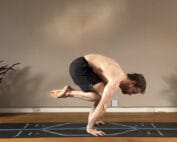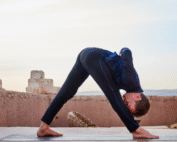
How to do Scorpion Pose (Vrischikasana) in Yoga?
Hi, Welcome to Dav Jones Yoga! Whether you’re just starting out or deepening your practice, our classes are designed to help you grow and find inspiration on your yoga journey. Today, we’re going to explore the numerous benefits of a challenging yoga pose name Vrischikasana or Scorpion Pose. Together, I’ll share insights how to do (Vrischikasana) Scorpion Pose in yoga correctly and safely.
What is Scorpion Pose (Vrischikasana) in Yoga?
The Scorpion Pose, or Vrischikasana, is a posture that is accessed by balancing the body on the forearms whilst bringing the spine into extension (back bending). It demands a harmonious balance of physical power to support the body in an inverted posture, flexibility in the spine to arch the back into extension, and concentration to maintain the balance in the inverted position. Esteemed for its ability to enhance the body’s resilience and the mind’s clarity, this pose stands as a pinnacle of the yoga asana practice. Scorpion Pose Yoga embodies the power of a disciplined, dedicated practice.
Scorpion Pose (Vrischikasana) basics
Sanskrit: Vrischikasana
Pronunciation: Vrish-chee-kah-sah-nah
Meaning of Vrischikasana: “Vrischika” means scorpion, reflecting the pose’s resemblance to a scorpion’s stance as it prepares to strike, with the tail arched over the back. This posture symbolizes the scorpion’s dynamic power, agility, and blend of danger and grace.
Yoga Level: Advanced
Pose Type: Inversion
Benefits: Strengthens the shoulders, arms, and back; enhances the flexibility of the spine; improves balance and concentration; stretches the abdominal region.
Props: A wall for support, a yoga block, and or a strap for hand and forearm placement.
Before practicing Scorpion Pose Yoga Prepare your body with these preparatory poses
Before practicing Scorpion Pose Yoga, it’s crucial to prepare the body with specific poses that can warm up the body and aid the practitioner in preparation for Scorpion Pose. These preparatory postures can help build the necessary flexibility, strength, and balance, ensuring a safer and more effective approach to mastering the pose.
Cobra Pose (Bhujangasana)
Increases spinal flexibility, crucial for the backbend in Scorpion Pose.

Bridge Pose (Setu Bandhasana)
Strengthens the back and legs while opening the chest, preparing the body for deeper backbends.

Camel Pose (Ustrasana)
Opens the front of the body and stretches the chest and shoulders.

Dolphin Pose
This is a primary posture to practice in preparation for the forearm stand and Scorpion Pose.

Breaking Down the Scorpion Pose (Vrischikasana) in Simple Steps
Stage 1: Establishing the Foundation with Mountain Pose (Tadasana)

To prepare for the Scorpion Pose (Vrischikasana), begin with the foundational Mountain Pose (Tadasana), focusing on the following key points:
- Ground Your Feet: Ensure your feet are firmly planted on the mat, with weight evenly distributed across both feet.
- Engage Your Muscles: Activate your leg muscles and core to create a stable base. Keep the spine elongated, lifting upwards from the crown of the head.
- Mindful Breathing: Maintain a calm and steady breath, which is essential for balance and focus in more advanced poses.
- Duration: Aim to hold Tadasana for 30 to 60 seconds, focusing on stability and a relaxed posture.
- Check for Tension: Ensure there is no tension in the neck or shoulders, keeping the body relaxed yet alert.
- Use of Props: Consider using a wall for slight back support to improve posture alignment, although it is optional.
Stage 2: Transitioning to Dolphin Pose

After establishing a strong foundation in Mountain Pose, the next step is to move into Dolphin Pose, which will build the upper body and core strength needed for Scorpion Pose. Focus on these key aspects:
- Position Your Hands and Elbows: Place your forearms on the mat shoulder-width apart, with your elbows directly under your shoulders. Interlace your fingers or keep your palms flat on the mat, depending on your comfort.
- Lift into the Pose: From a kneeling position, tuck your toes and lift your hips up and back, similar to Downward Facing Dog but on your forearms.
- Engage Your Core: Activate your core muscles to support the spine and maintain balance.
- Keep Your Head Elevated: Ensure your head is off the floor, neck long, and gaze down between your arms to maintain spinal alignment.
- Hold the Pose: Aim to hold Dolphin Pose for 30 to 60 seconds, focusing on building strength in the shoulders, arms, and core.
- Breathing: Maintain even and deep breaths to help stabilize and deepen the pose.
Stage 3. Lift into the forearm stand (Pincha Mayurasana)

Building on the strength and stability developed in Dolphin Pose, progress to the Forearm Stand (Pincha Mayurasana). This stage is crucial for mastering the balance and control needed for Scorpion Pose. Focus on these essential steps:
- Align Your Forearms: Ensure your forearms remain parallel or your hands interlaced, with elbows at shoulder width to form a stable base.
- Kick Up Gradually: From Dolphin Pose, walk your feet closer to your elbows to decrease the angle at your hips, and gently kick one leg up at a time towards the ceiling. For beginners, practicing near a wall can provide additional support and safety.
- Engage Your Core and Legs: Strong core engagement is crucial to stabilizing the torso in the air. Keep your legs active and extended upwards, with your toes pointed.
- Focus on Alignment: Keep your hips over your shoulders and your shoulders away from the ears to maintain a straight line through the body.
- Hold the Pose: Try to maintain the pose for a few seconds initially, building up to longer as you gain confidence and strength.
- Breathing: Maintain calm and steady breathing to help focus and balance in the pose.
Stage 4. Transitioning into Scorpion Pose

Once you’ve established confidence in Forearm Stand, you’re ready to transition into the Scorpion Pose. Follow these steps to make a smooth and controlled transition:
- Shift Your Focus: Begin by shifting your gaze slightly forward to prepare for the change in balance and orientation.
- Bend Your Knees: While maintaining stability in the Forearm Stand, slowly begin to bend your knees, bringing them towards your chest.
- Engage Your Core: Keep your core engaged to maintain stability and control as you initiate the movement.
- Lift Your Hips: As you bend your knees, simultaneously lift your hips higher towards the ceiling, creating space for your legs to extend overhead.
- Extend Your Legs: Once your hips are lifted, straighten your legs upwards towards the ceiling, aiming to reach a fully extended position.
- Point Your Toes: As you extend your legs, point your toes toward the ceiling to create a smooth and graceful line.
- Maintain Balance: Focus on maintaining balance and stability throughout the transition, using your core strength and breath to support you.
- Hold the Pose: Once you’ve reached the full expression of Scorpion Pose, hold the position for a few breaths, enjoying the inversion and the sense of accomplishment.
Tips for beginners
For beginners approaching Scorpion Pose, start with foundational practices to build strength and flexibility. Focus on forearm balance and backbend exercises. Use props, like a wall or yoga blocks, for support and safety. Practice regularly, but listen to your body to avoid overexertion. Progress gradually, valuing alignment and stability over achieving the final pose. Prioritize patience and self-compassion with this challenging yoga posture.
The Transformative Benefits of Scorpion Pose
Modifications and Props for Scorpion Pose Yoga:
Common mistakes to avoid:
Contraindications and Cautions:
Final Thought
Whether you’re taking your first steps into the world of yoga or you’re an experienced practitioner seeking to deepen your skills, our online classes provide tailored instruction for mastering the Scorpion Pose (Vrischikasana). Connect with Dav Jones Yoga on the Patreon channel or have a look at the DJY Mentorship programs.









